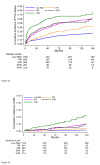Modified risk stratification grouping using standard clinical and biopsy information for patients undergoing radical prostatectomy: Results from SEARCH
- PMID: 28994485
- PMCID: PMC5685668
- DOI: 10.1002/pros.23436
Modified risk stratification grouping using standard clinical and biopsy information for patients undergoing radical prostatectomy: Results from SEARCH
Abstract
Introduction: Prostate cancer is a heterogeneous disease, and risk stratification systems have been proposed to guide treatment decisions. However, significant heterogeneity remains for those with unfavorable-risk disease.
Methods: This study included 3335 patients undergoing radical prostatectomy without adjuvant radiotherapy in the SEARCH database. High-risk patients were dichotomized into standard and very high-risk (VHR) groups based on primary Gleason pattern, percentage of positive biopsy cores (PPBC), number of NCCN high-risk factors, and stage T3b-T4 disease. Similarly, intermediate-risk prostate cancer was separated into favorable and unfavorable groups based on primary Gleason pattern, PPBC, and number of NCCN intermediate-risk factors.
Results: Median follow-up was 78 months. Patients with VHR prostate cancer had significantly worse PSA relapse-free survival (PSA-RFS, P < 0.001), distant metastasis (DM, P = 0.004), and prostate cancer-specific mortality (PCSM, P = 0.015) in comparison to standard high-risk (SHR) patients in multivariable analyses. By contrast, there was no significant difference in PSA-RFS, DM, or PCSM between SHR and unfavorable intermediate-risk (UIR) patients. Therefore, we propose a novel risk stratification system: Group 1 (low-risk), Group 2 (favorable intermediate-risk), Group 3 (UIR and SHR), and Group 4 (VHR). The c-index of this new grouping was 0.683 for PSA-RFS and 0.800 for metastases, compared to NCCN-risk groups which yield 0.666 for PSA-RFS and 0.764 for metastases.
Conclusions: Patients classified as VHR have markedly increased rates of PSA relapse, DM, and PCSM in comparison to SHR patients, whereas UIR and SHR patients have similar prognosis. Novel therapeutic strategies are needed for patients with VHR, likely involving multimodality therapy.
Keywords: prostate cancer; risk stratification; unfavorable intermediate risk; very high-risk prostate cancer.
© 2017 Wiley Periodicals, Inc.
Conflict of interest statement
The authors have no conflicts of interest relevant to this manuscript to report
Figures




Similar articles
-
Unification of favourable intermediate-, unfavourable intermediate-, and very high-risk stratification criteria for prostate cancer.BJU Int. 2017 Nov;120(5B):E87-E95. doi: 10.1111/bju.13903. Epub 2017 Jun 3. BJU Int. 2017. PMID: 28464446
-
Number of Unfavorable Intermediate-Risk Factors Predicts Pathologic Upstaging and Prostate Cancer-Specific Mortality Following Radical Prostatectomy: Results From the SEARCH Database.Prostate. 2017 Feb;77(2):154-163. doi: 10.1002/pros.23255. Epub 2016 Sep 29. Prostate. 2017. PMID: 27683213
-
Improved decision making in intermediate-risk prostate cancer: a multicenter study on pathologic and oncologic outcomes after radical prostatectomy.World J Urol. 2017 Aug;35(8):1191-1197. doi: 10.1007/s00345-016-1979-z. Epub 2016 Dec 16. World J Urol. 2017. PMID: 27987030
-
A new risk classification system for therapeutic decision making with intermediate-risk prostate cancer patients undergoing dose-escalated external-beam radiation therapy.Eur Urol. 2013 Dec;64(6):895-902. doi: 10.1016/j.eururo.2013.03.033. Epub 2013 Mar 23. Eur Urol. 2013. PMID: 23541457
-
Association of absolute amount of pattern 4 disease on prostate biopsy with oncologic outcomes in intermediate-risk prostate cancer A systematic review.Can Urol Assoc J. 2025 Jun;19(6):211-216. doi: 10.5489/cuaj.8995. Can Urol Assoc J. 2025. PMID: 40031947 Free PMC article. Review.
Cited by
-
Predicting the probability of pT3 or higher pathological stage at radical prostatectomy: COVID19-specific considerations.Front Oncol. 2022 Dec 6;12:990851. doi: 10.3389/fonc.2022.990851. eCollection 2022. Front Oncol. 2022. PMID: 36561531 Free PMC article.
-
Revisiting current National Comprehensive Cancer Network (NCCN) high-risk prostate cancer stratification: a National Cancer Database analysis.Prostate Cancer Prostatic Dis. 2024 Jun;27(2):244-251. doi: 10.1038/s41391-022-00621-7. Epub 2023 Jan 14. Prostate Cancer Prostatic Dis. 2024. PMID: 36641534
References
-
- Klotz L, Vesprini D, Sethukavalan P, et al. Long-term follow-up of a large active surveillance cohort of patients with prostate cancer. J Clin Oncol. 2015;33:272–7. - PubMed
-
- Mohler JL, Kantoff PW, Armstrong AJ, et al. Prostate cancer, version 2.2014. J Natl Compr Canc Netw. 2014;12:686–718. - PubMed
Publication types
MeSH terms
Grants and funding
LinkOut - more resources
Full Text Sources
Other Literature Sources
Medical
Research Materials
Miscellaneous

